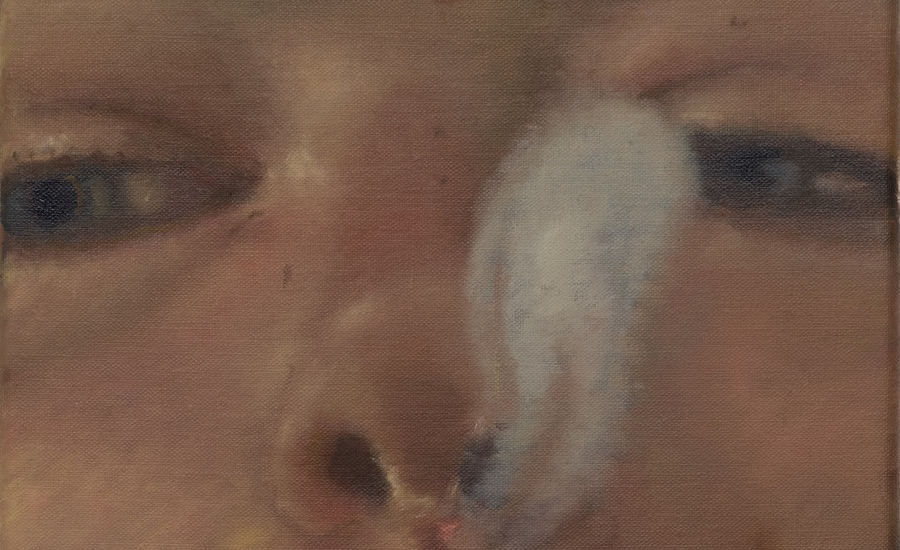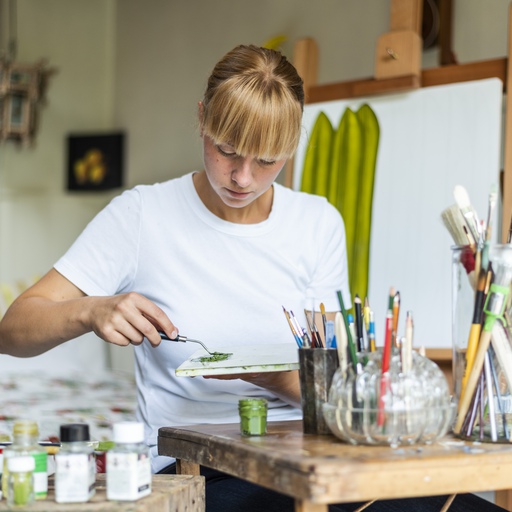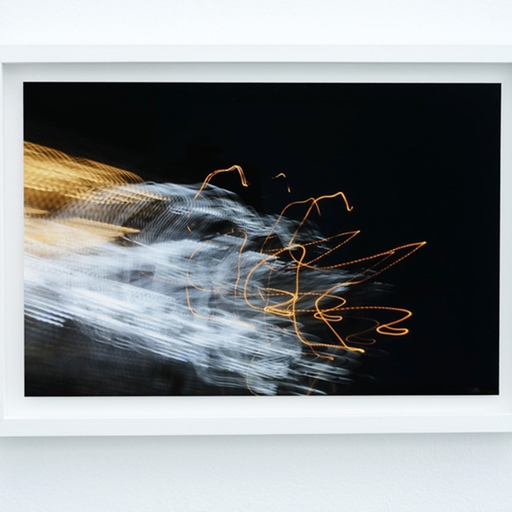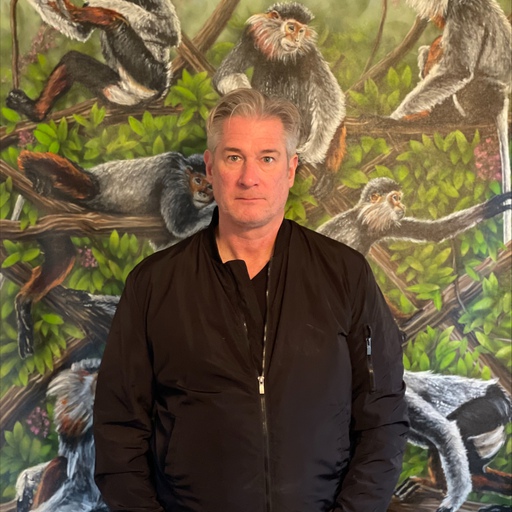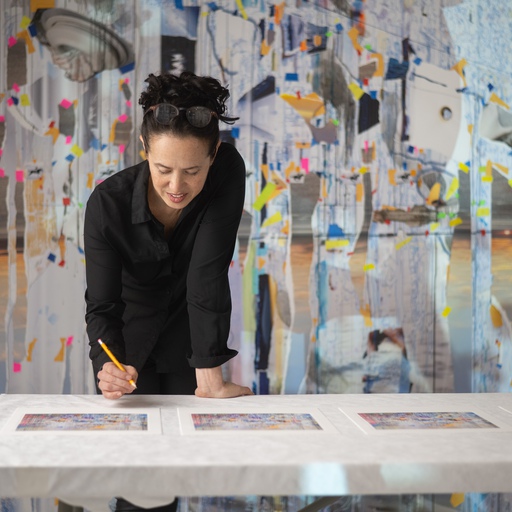No one in the art world is making moves quite like Issy Wood . This 30-year-old, US-born, London-based artist has collectors and gallerists clamoring for the beautifully obscure, strangely still views which she depicts in her near-photorealistic paintings – works seem to find a static space between realism and surrealism (writing in ArtForum, the critic and art historian Barry Schwabsky characterized her style as ‘ perverted realism’).
Yet while those images occupy the kinky corners of gallery goers minds, Woods’ dynamic, counterintuitive career moves take up the center ground in contemporary arts commentary.
A graduate of both Goldsmiths and the Royal Academy in London, Wood not only paints but also records music and writes sharp, diaristic prose; the Gagosian gallery attempted to represent her works on canvas, while the music producer Mark Ronson sought to release Wood’s music via Sony Music. She rebuffed both these advances, choosing to release her album, My Body Your Choice, independently, while pairing up with Michael Werner gallery for a solo exhibition, Time Sensitive in Manhattan last September. Her next exhibition will open at Carlos/Ishikawa in May .
Succeeding despite these rebuttals only underscores Wood’s talent and hard-scrabble grit. In this interview she describes her maniacal working practices, why she’s still reeling from lockdown, and how her parents’ medical careers shaped her view of the human body.
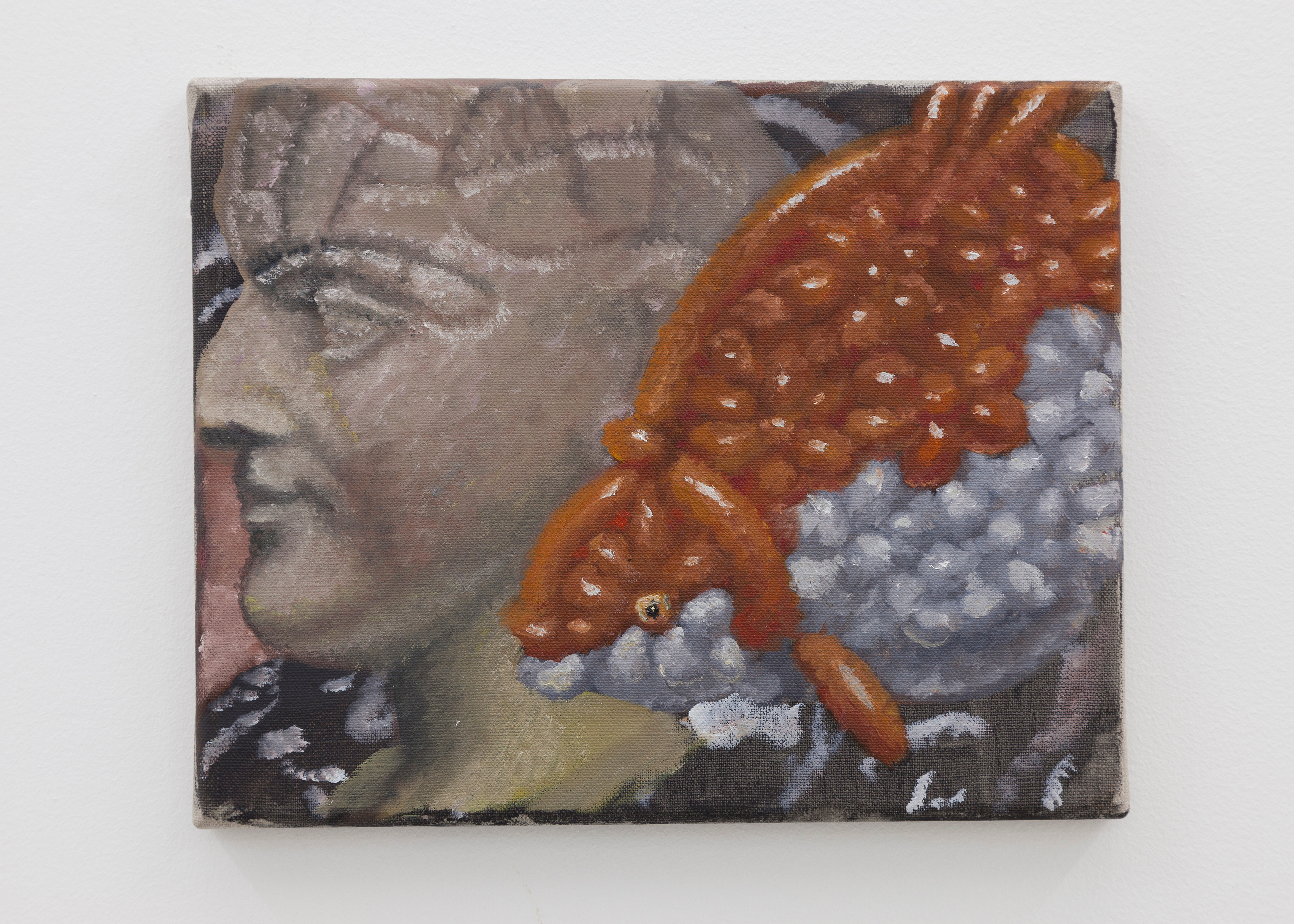
Issy Wood - It All / study for bestiality, 2019 oil on linen 24.5 × 30 × 1.5 cm
© Issy Wood 2023, courtesy the artist; Carlos/Ishikawa, London; and Michael Werner, New York. Photography by Stephen James.
How would you describe what you do to someone who’s never seen one of your works? I do what a “creative child” does for free, but for a living.
There is a kind of “confusion” to what you do, is that something you’re conscious of when you’re creating the work or that appears to you when you’ve finished a particular piece? I’m not sure awareness of confusion, or full awareness of anything for that matter, has a place in my studio. Lately it’s mostly an exercise in blocking things out, keeping an almost delusional distance from the world and my own thoughts. Perhaps ambivalence is useful, but it’s delicate. A lot of my subject matter is chosen for its promise of the pristine, and I’ve assigned myself the task of showing how this promise is broken almost every time.
 Issy Wood - All the rage 2, 2019 oil on linen 100 × 140 cm © Issy Wood 2023, courtesy the artist; Carlos/Ishikawa, London; and Michael Werner, New York. Photography by Stephen James.
Issy Wood - All the rage 2, 2019 oil on linen 100 × 140 cm © Issy Wood 2023, courtesy the artist; Carlos/Ishikawa, London; and Michael Werner, New York. Photography by Stephen James.
What do you think about when you’re painting? I don’t think much. I have never, for instance, been able to carry out a conversation while painting if there’s someone in the room. I think this is normal. If there’s anything tangible going on in my head, it’s the question, “is this the right color?”, and then the statement “the guest on this podcast is an idiot”.
Is there a typical day for you when it comes to painting? Are you structured in your approach, or do you just dive in and see where you go? I stay structured because there’s something unnerving to me about not having a predetermined schedule. I often long for rules similar to those of school or an office. Unfortunately I am a horrifyingly cruel boss and work to the point of fatigue seven days a week. I would report myself to a tribunal of some kind if I could. Now that I’m 30 I am trying to cool it and, as my friend Lena once said, “start caring about silly things like quality of life”

Issy Wood - First wives with dentistry, 2020 Oil on linen 140 x 100 x 4.5 cm
55 1/8 x 39 3/8 x 1 3/4 in © Issy Wood 2023, courtesy the artist; Carlos/Ishikawa, London; and Michael Werner, New York. Photography by Stephen James.
When in your experience do you find that inspiration is most likely to strike? Can you tease it along and force an appearance? It rarely strikes, because I try not to let the idea pot go cold. I keep it simmering by working on multiple things at all times - including writing and music. I have a lot of my older paintings in the studio to remind me of my own motifs so that it all feels like one big conversation rather than a string of stabs in the dark. Also it’s good for the ego to keep past successes at arm’s reach.
Do you follow where the painting is taking you or try to tame it and control it? Depends on the painting.
Do you have a good time making the various kinds of work? Does the experience between mediums differ, or is there a link? I don’t know if “good time” is the correct phrase, but I do believe I will perish of sadness if I don’t make all this stuff. The mediums fence themselves off or blur together at different times. The painting is the sturdiest venture, the music is often hell on earth, and the writing is a gathering together of whatever was left unsaid by the painting and music.

Issy Wood - Goldie Hawn’s character with drinking problem, 2020 Oil on linen 240 x 182.5 x 5 cm 94 1/2 x 71 7/8 x 2 in © Issy Wood 2023, courtesy the artist; Carlos/Ishikawa, London; and Michael Werner, New York. Photography by Stephen James.
Lockdown seemed to create a very fertile moment in your imagination and in your output. How has it changed since then and what do you think you’ve lost or gained along the way? I am still recovering, socially, from lockdown. Living and working alone, it is neither normal nor healthy to be starved of physical touch for that long. I did like that period because it was the first time everybody had to be as hermetic as me. I feel very lucky that when the pandemic happened, I had met all of the best people - professionally and personally - to see me through such a bizarre event. I think I was also realistic about what the extra time and stasis could offer - I knew I wasn’t going to learn Japanese or write a screenplay. I just kept chipping away at existing projects.
How is your work changing at the moment? In the studio I try to keep a good balance of maintenance (existing series, familiar lines of thought) and innovation (risky formal leaps of faith that could end in total heartbreak). I need the former to lay a foundation for the latter. A little like wearing knee pads while roller skating.
 Issy Wood - Expensive Minaudière 2, 2017 rowan cowan Oil on canvas 18 × 24 cm © Issy Wood 2023, courtesy the artist; Carlos/Ishikawa, London; and Michael Werner, New York. Photography by Stephen James.
Issy Wood - Expensive Minaudière 2, 2017 rowan cowan Oil on canvas 18 × 24 cm © Issy Wood 2023, courtesy the artist; Carlos/Ishikawa, London; and Michael Werner, New York. Photography by Stephen James.
This is a kind of ownership and impulse question. Do you ever think about the dichotomy between the images that you absolutely have to paint and where a similar compelling desire from a collector to own them might kick in? I try not to think about collectors too much. I’m positive the reasons people have for buying my art run the gamut: from cynical to earnest, financial to spiritual. I think more about the other end of the food chain - the auction catalog photographers, the pattern cutters, the car owners, the furniture upholsterers, the people hand-painting sets of porcelain or figurines. A lot of what I look at I find a little hideous.

Issy Wood - All the rage 1, 2019 oil on linen 100 × 140 cm © Issy Wood 2023, courtesy the artist; Carlos/Ishikawa, London; and Michael Werner, New York. Photography by Stephen
How does the buzz around your work feel? Are you able to disassociate yourself from it, or does there come a point where you ‘have to’ jump in and soak up the noise? Have you received any good advice you cling to? Last year was one long exercise in forgetting buzz. I generally write about it on my blog, and the many weird interactions that spring from having something people want. Friends sometimes show me artists who are copying me, and this is funny and flattering. The best advice to date is “it’s a marathon, not a sprint”.
You have spoken about your battles with mental health and bulimia in the past, but your work seems extremely confident and focused; is it a way of controlling the imbalances and impulses we all have, so that you can actually succeed and be in control? I’ve channeled as many of my worst habits into making art as I can. There are still a few left over. Turns out you can’t rely on any one thing to solve all your problems. I work with two gallerists who know my story and my brain very well. I’m one of those strange artists being asked to work less by their dealers. Everybody is trying to get me to take a holiday.
 Issy Wood - The tilt 2, 2021 Oil on velvet 57.5 x 44.5 x 5 cm 22 5/8 x 17 1/2 x 2 in © Issy Wood 2023, courtesy the artist; Carlos/Ishikawa, London; and Michael Werner, New York. Photography by Stephen James.
Issy Wood - The tilt 2, 2021 Oil on velvet 57.5 x 44.5 x 5 cm 22 5/8 x 17 1/2 x 2 in © Issy Wood 2023, courtesy the artist; Carlos/Ishikawa, London; and Michael Werner, New York. Photography by Stephen James.
You’ve spoken about thinking about a body with a level of sterility, and how efficient your parents were at talking about a body as though it has no one inside it. As you grow as an artist do you find a new relationship with the body that is separate from the kind perhaps received via your childhood experiences? I was raised by doctors. Everything I thought was objective about the body as a kid later revealed itself to be entirely subjective.
You had a brief brush with Mark Ronson and Sony Music. Did the attitude of the music industry (thirst traps etc) shock you in terms of how chronically backward it still is when it comes to marketing female musicians and artists? What shocked me is how naive I was going into that whole venture. Later I realized a label is closer to a bank than a supportive or nurturing structure. As I’ve said before, the entire experience was worth it just for the gratitude it left me with for the art world. In music label terms - ones that prefer you 19-years-old to 29 - I was a geriatric performer. I lucked out with my main career being one that doesn’t prioritize youth in the same way. In fact, things seem to get better as you get older in this industry.
Your exhibition titles are great - All the Rage a particular favorite - how do you come by them, does the work suggest the title, or do you set yourself a target of creating work that reflects the thoughts going through your head at the time? I have a long, running list of titles in my Notes app, and when it comes to titling things - paintings, shows, songs, EPs - it’s just a case of matching the title to its most relevant partner. Like speed dating.

Issy Wood - What if you showed up, 2021 Oil on velvet upholstered modular sofa system (Carlo Scarpa c. 1930), rosewood, brass Overall installed dimensions variable © Issy Wood 2023, courtesy the artist; Carlos/Ishikawa, London; and Michael Werner, New York. Photography by Stephen James.
Do you ever wonder if Joan Rivers became a kind of cypher, an accidental placeholder for some of the issues you’d been working through, or do you think in retrospect it was more conscious and the only way you could address that painful subject matter in your work? Yes.
Do you think you are able to confront it with a different head on now? I wish I had a different head.
What did you learn from working with Lena Dunham and Alison Katz? That it’s not a crime to be a woman or a painter.
Can you give us an early indication as to what the next show of work might be called? The next shows are going to be in Seoul and Paris, so in my mind the titles need to translate easily.
 Issy Wood - When You I Feel, 2017 Oil on canvas 165 × 285 cm © Issy Wood 2023, courtesy the artist; Carlos/Ishikawa, London; and Michael Werner, New York. Photography by Stephen James.
Issy Wood - When You I Feel, 2017 Oil on canvas 165 × 285 cm © Issy Wood 2023, courtesy the artist; Carlos/Ishikawa, London; and Michael Werner, New York. Photography by Stephen James.
You’ve spoken of some of your work as outtakes in the past. Are you interested in that kind of nothing-goes-to-waste aesthetic? I think I spoke about the smaller paintings as outtakes a while ago, when they were just my answer to drawing or sketching. Nowadays the small paintings are some of my best work. I don’t like waste of any kind, but there are always some ugly steps along the way to a great piece of art that probably ought not to be seen. At least until after the artist is dead.
See Wood’s work, very much within her lifetime, by taking a look at her artist page on Artspace.











